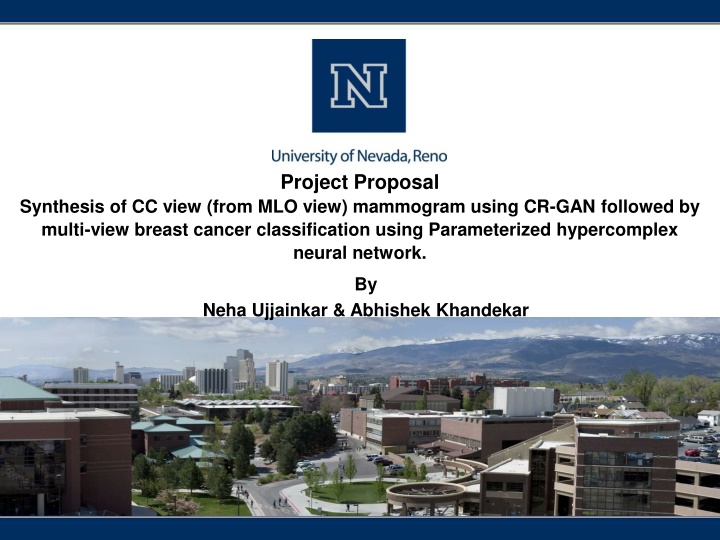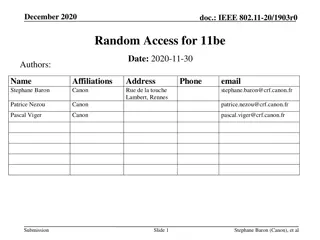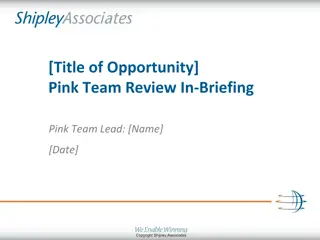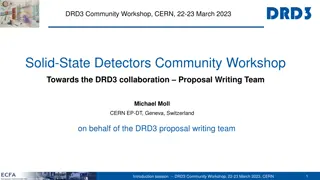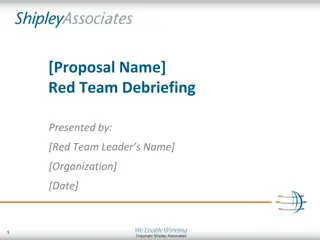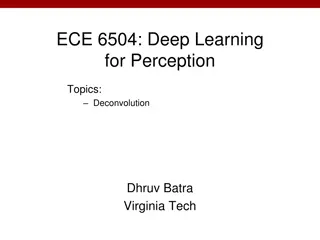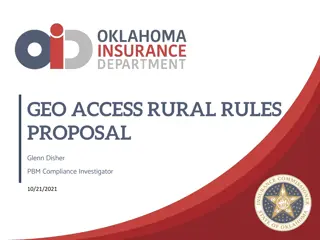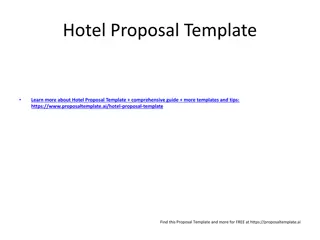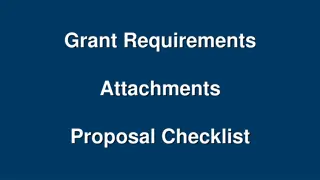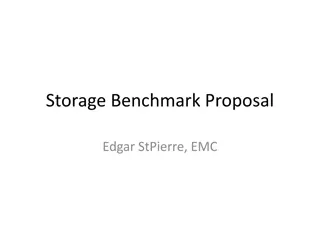Project Proposal
This project proposal focuses on synthesizing CC view mammograms from MLO view using CR-GAN, followed by multi-view breast cancer classification employing a Parameterized Hypercomplex Neural Network (PHNN). By leveraging advanced deep learning techniques, the aim is to improve classification accuracy and obtain complete representations for enhanced diagnostics. The significance lies in the potential for superior quality mammogram synthesis and robust classification, ultimately enhancing breast cancer detection and treatment outcomes.
Download Presentation

Please find below an Image/Link to download the presentation.
The content on the website is provided AS IS for your information and personal use only. It may not be sold, licensed, or shared on other websites without obtaining consent from the author.If you encounter any issues during the download, it is possible that the publisher has removed the file from their server.
You are allowed to download the files provided on this website for personal or commercial use, subject to the condition that they are used lawfully. All files are the property of their respective owners.
The content on the website is provided AS IS for your information and personal use only. It may not be sold, licensed, or shared on other websites without obtaining consent from the author.
E N D
Presentation Transcript
Project Proposal Synthesis of CC view (from MLO view) mammogram using CR-GAN followed by multi-view breast cancer classification using Parameterized hypercomplex neural network. By Neha Ujjainkar & Abhishek Khandekar
Outline Problem Statement Introduction Literature Review Data set Significance Experiment Design Timeline and Milestones References 2
. Problem Statement Synthesis of CC view (from MLO view) mammogram using CR-GAN followed by multi-view breast cancer classification using Parameterized hypercomplex neural network. 3
. Introduction CR-GAN to generate CC-view mammograms from MLO view data. CR-GAN uses a two-pathway framework to achieve the complete representation. Next, classify multi-view breast cancer on the MLO, CC view pair using the Parameterized hypercomplex neural network (PHNN). 4
. Literature review CR-GAN: Learning Complete Representations for Multi-view Generation by Yu Tian et al. Two-View Mammogram Synthesis from Single-View Data Using Generative Adversarial Networks by Asumi Yamazaki et al. Hypercomplex Neural Architectures for Multi-View Breast Cancer Classification by Lopez et al. High-Resolution Breast Cancer Screening with Multi-View Deep Convolutional Neural Networks by Geras et al. 5
. Dataset 1054 pairs from CBIS-DDSM (3000 x 4500 to 4000 x 5700) 188 pairs from INBreast (3328 x 4084 or 2560 x 3328) 330 pairs from MIAS (1024x1024) 6
. Significance This approach may improve the accuracy of breast cancer classification by using PHResNet on both single-view mammographs (MLO views) and the generated CC views. (from MLO views) CR-GAN will help enable coverage of the whole latent space and learning of complete representations, which was impossible in single pathway GAN. Higher resolution and superior quality mammogram syntheses will be achieved by using the Progressive growing technique and Feature matching loss. Parameterized hypercomplex ResNet will leverage information contained in multiple views through parameterized hypercomplex convolutional (PHC) layers in order to obtain a more performant and robust classifier for breast cancer. Instead of handling the mammographic views independently, which results in losing significant correlations, this model processes them as a unique component, without breaking the original nature of the exam. PHC-based models possess half the number of free parameters. 7
. Experiment Design Tech/Tools/Systems Pre-processing Method Training Evaluation 8
Tech/Tools/Systems The coding will be done in Python (Pytorch & Open CV) Plan to use Google Colab for Python coding. We will choose the hyperparameters and batch size at the time of training 9
. Pre-processing Data augmentation to the images from CBIS-DDSM and INBreast. Zooming (in or out) High-frequency enhancements Contrast and brightness adjustments Image rotations, and image shifts. 10
. Method Task 1: CC view generation from the MLO view by using the CR-GAN network. Task 2: To employ parameterized hypercomplex ResNets (PHResNets) for multi-view breast cancer classification 11
Training Task 1: 80% of pairs will be used for training 20% of pairs will be used for testing. Task 2: Pre-train the model on patches of mammograms Use the pre-trained weights to initialize the network for training on whole images. 80% of pairs will be used for training 20% of pairs will be used for testing. 12
. Evaluation Task 1: Peak signal-to-noise ratio (PSNR) Structural similarity (SSIM) Multi-scale SSIM (MS-SSIM) Cosine similarity (Cos_sim) Task 2: AUC (Area Under the ROC Curve) Classification accuracy. 13
. Timeline and Milestones Task 1: Generation of CC views (from MLO views) Task 2: Multi-view breast cancer classification using Parameterized hypercomplex neural network. Completion Date 10/08/2023 10/16/2023 10/22/2023 10/29/2023 11/05/2023 11/12/2023 11/19/2023 Sr. No. 1 2 2 3 4 5 6 Milestone Duration 1 week 1 week 1 week 1 week 1 week 1 week 1 week Defining the problem statement. Submit the Project Proposal. Data exploration and data analysis for task 1. Data augmentation for task 1. Splitting the data and training the model for task 1. Evaluate the performance of the model for task 1 Data Exploration and data analysis for task 2 Splitting the data and pretraining the network on patches for task 2 Splitting the data and training the model on the whole image for task 2. Evaluate the performance of the model for task 2. Final testing. Project Presentation Submit Final Project Report. 7 1 week 11/26/2023 8 1 week 12/03/2023 9 1 week 1 week 1 week 1 week 12/10/2023 12/17/2023 12/20/2023 12/23/2023 10 11 12 14
References 1. Yamazaki, A., & Ishida, T. (2022). Two-View Mammogram Synthesis from Single-View Data Using Generative Adversarial Networks. Applied Sciences, 12(23), 12206. https://www.mdpi.com/2076- 3417/12/23/12206 2. Tian, Y., Peng, X., Zhao, L., Zhang, S., & Metaxas, D. N. (2018). CR-GAN: learning complete representations for multi-view generation. arXiv preprint arXiv:1806.11191. https://arxiv.org/abs/1806.11191 3. Geras, K. J., Wolfson, S., Shen, Y., Wu, N., Kim, S., Kim, E., ... & Cho, K. (2017). High-resolution breast cancer screening with multi-view deep convolutional neural networks. arXiv preprint arXiv:1703.07047. https://arxiv.org/abs/1703.07047 4. Lopez, E., Grassucci, E., Valleriani, M., & Comminiello, D. (2022). Multi-View Breast Cancer Classification via Hypercomplex Neural Networks. arXiv e-prints, arXiv-2204. https://arxiv.org/pdf/2204.05798.pdf 5.Liu, Y., Zhang, F., Chen, C., Wang, S., Wang, Y., & Yu, Y. (2021). Act like a radiologist: towards reliable multi- view correspondence reasoning for mammogram mass detection. IEEE Transactions on Pattern Analysis and Machine Intelligence, 44(10), 5947-5961. https://ieeexplore.ieee.org/abstract/document/9444895 6.Yang, Z., Cao, Z., Zhang, Y., Tang, Y., Lin, X., Ouyang, R., ... & Ma, J. (2021). MommiNet-v2: Mammographic multi-view mass identification networks. Medical Image Analysis, 73, 102204. https://www.sciencedirect.com/science/article/pii/S1361841521002498 15
. Thank You 16
